Abstract
Research on solutions for climate change in the urban transport sector has focused primarily on the technological and spatial planning perspectives; the social dimension of behavioral changes is relatively less explored, particularly in the southern European small city context. In this paper, we examine how social determinants and two other endogenous factors—motivation and knowledge—influence sustainable mobility choices in Portugal, through a case study of a city micro-mobility pilot, using the Elaboration Likelihood Model (ELM) and the Social Information Processing Theory (SIPT) as an analytical framework, and mix-method analysis from questionnaires, in-depth individual interviews, and other information collected throughout the pilot program. Motivation, as we found, was the strongest factor that contributed to comprehension, leading to a primarily positive attitude change towards pro-environmental behavior. Our research emphasizes the importance of mechanisms that stimulate citizens’ motivation and facilitate communication in sustainability pilot programs.
1. Introduction
Cities account for a majority of atmospheric carbon emissions. From a governance perspective, they contain great potential for climate action and solutions as capable actors in addressing climate change via the effective direct policy mobilization of many key sectors. The transport sector is one of them. In the European Union, road transport represents 17% of total energy-related greenhouse gas (GHG) emissions [1]. Besides being a critical emission source, the transport sector, particularly in urban areas, also influences urban health and is deeply embedded into the social fabric. Mobility is an essential practice shaping everyday urban life and social relations, while a low-carbon lifestyle is becoming an emergent practice globally. The IPCC reports urge for an urgent shift to sustainable urban mobility as one of the most critical behavior changes needed to address climate change in cities today [2,3].
Effective policies plus a pinch of novelty can quickly build the capacity in both the public and private sectors to support citizens to adopt more sustainable behaviors and lifestyles. For cities, this often means the adoption or introduction of new technologies and making them accessible for citizens at low cost, and has been seen practiced in the transport sector. On the one hand, cities are critical actors for climate action and curbing CO2 emissions [4,5,6]. Urban sustainable mobility pilots have become a popular way to test the credibility and effectiveness of climate solutions [7,8]. They can accelerate the learning curves of communities and municipalities to adopt new sustainable behaviors in day-to-day life and new technologies that promote them. The importance of sustainable urban mobility policies has led municipalities to frequently adopt pilots as a tool for accelerating decision-making and, as far as possible, representing their population [9,10,11].
On the other hand, research on the transport sector as an urban climate change solution has focused primarily on the technological and spatial planning perspectives, but the social dimension—the embodiment of the sustainability notions and lifestyle changes resulting from behavioral changes—is relatively less explored, particularly in the southern European small city context [12].
Therefore, our research questions are: what are the individual and social factors that determine the perception and choices of urban sustainable mobility and how does communication contribute to pro-environmental behavior? Our objective is to contribute to the theoretical and practical understandings of social determinants in sustainability mobility choice, thereby providing more evidence for policymaking and urban planning.
Local policies for sustainable urban mobility have the potential to develop closer approaches to citizens and thus have a more direct impact, as it is the level of governance closest to individual and community mobility users. Decision makers must know who their target audience is (social determinants), the individual factors that also matter (motivation and knowledge about sustainability) and how to effectively communicate with them. The Elaboration Likelihood Model (ELM) and the Social Information Processing Theory (SIPT) are two suitable theories as a basis for analytical tools for this purpose, as the first focuses on the attitude change process and the second explores modes of interpersonal online and face-to-face communication.
We try to answer the research questions by studying an urban (electric) bike-sharing pilot program in Matosinhos, Portugal, a southern European small city context. In particular, our study examines the influence of individual, social factors and communication on the participants’ mobility choices and their perception of sustainability. The mobility pilot was conducted to establish a new local market-oriented instrument for emissions reduction, by allowing individuals to record and trade their avoided emissions voluntarily.
The second chapter reviews the relevant literature from sociology and social psychology, and communication disciplines on consumer behaviors and choices in transport, technology, sustainability, and behavioral change. The third chapter introduces the analytical framework composed of the ELM and the SIPT. The fourth chapter introduces the methodology, including the pilot structure and process, data collection, and analysis. The fifth and sixth chapters present the findings, discussions, and conclusions.
2. Existing Research on Behaviors and Choices in Transport, Technology, Sustainability, and Behavioral Change
E-bikes and e-scooters, which in some cities represent up to 30% of the motor vehicle fleet, are the new urban mobility assets, but they also challenge traffic management and safety [13]. Adopting biking as a sustainable urban transport mode for many cities requires behavior change research and policy intervention to understand it [14]. A greater range of e-bikes makes them more capable of replacing car travel, thereby avoid CO2 emissions, particularly in small urban areas outside big cities [15,16,17]. By using e-bikes, consumers may reduce 12% of their emissions, after accounting for e-bike emissions from electricity generation and induced e-bike trips [18], and their life cycle CO2 emissions per km are five times lower than those from a car [19].
Cairns et al. [20] observed a consistent pattern in the European literature on using e-bikes: people become used to e-bikes when they are available; e-bike trips substitute a proportion of car use; and many people who take part become interested in e-bike-share services. With aggregate scale, new levels of patterns emerge. In Norway, Fyhri and Fearnley [21] registered an increase in e-bike usage over time and the increase was greater for females than for male cyclists, but with no differences in age. Expanding the cycling network not only attracts more cyclists, like in Copenhagen, but also increases walking activities, such as in Singapore [22]. However, some urban users tend to replace conventional bike trips with e-bikes, reducing physical activity. Meanwhile, in Italy, tough measures were tested (cycling incentive, driving disincentive, and a combination of the two) due to the low proportion of people cycling. But Sottile et al. [23] argue that even though the tough measures were necessary, they are not sufficient for consumers to adopt a sustainable mobility style consistently.
Research on transport choices illustrates the complexity of aspects that should be included in the decision-making process. Support for active mobility, that is, one that leads individuals to choose sustainable mobility, involves policies that bring together transport planning, urban planning, and public health [24], given the substantial synergies that can be gained from interdisciplinary collaboration in research and practice. The intention to switch from cars to public transport can serve as the primary predictor of behavioral readiness [25], although environmental reasons, among other motives (status, financial, independence, safety, and hedonism), are the most relevant predictor of mobility purchase intentions [26]. To understand and predict the trends of PEB, there are still knowledge gaps, particularly on: whether and how pro-environmental habits formed from rational decision making, and whether they are influenced by intrinsic motivations such as values, norms, and intentions [27,28]. The more optimistic perspectives suggest that the purpose of a trip, e.g., remoding (changing mode), retiming, rescheduling, rerouting, relocating, reallocating, and reducing journey purposes, is a critical determinant of multimodal travel behavior [29,30].
Regarding health co-benefits of sustainable mobility, early research did not include those of e-bikes, and it was consensual that the benefits of replacing cars with bicycles far outweighed the costs of injury from road crashes [31]. More recently, studies on e-bike use revealed its relation not only to a reduction in motorized vehicle use, but also to better health, well-being, and environmental outcomes such as decreasing traffic noise, air pollution and GHG emissions [17,18,32], although cycling might not be entirely substitutable for physical activity [33,34].
Overall, research insights from social psychology, sociology, communication, and behavioral economics contribute to more effective transport policies that promote pro-environmental behavior (PEB). PEB, defined as behavior that consciously protects the environment and improves it, is a multidisciplinary issue [35]. However, the several different labels that have defined PEB probably have not reflected the evolving knowledge and concerns well, as many policies and pledges made to contain global warming and biodiversity loss have been considered failures.
Nevertheless, social sciences are still the ground for soft policy and moral persuasion tools. Soft policies look to these disciplines for insights into social determinants and mechanisms of individual and community well-being. Social determinants became a key concept in social sciences research on individuals and social organizations in different contexts [36]. Biehl et al. [37] argue that the growth of sociology and social psychology research is a response to the dissatisfaction with the normative theory of decision. Meanwhile, the literature has noted an expansion of soft policies in recent decades that was interrupted by the hard policy instruments of the COVID-19 period [38].
Environmental concern, associated with increased levels of environmental knowledge and environmental risk perception, can strongly influence behavioral intention and both act as mediators of sustainable consumption behavior [39], although effective persuasive communication models that promote and predict PEB are still very much needed [40].
At the individual level, information has a critical role in motivating mode shifting [12]. Researchers on behavior and choice have been expanding the theoretical scopes in recent years by adding new aspects and integrating theories related to communication.
In addition, many theories from social psychology have also been used to research sustainable behavior change, such as several frameworks of behavior change [41] or the Model of Goal-Directed Behavior (MGDB). The most used is the Planned Behavior Theory [42,43].
Scholars try to approach this expansion with meta-analyses of primary studies, and theory frameworks such as the Theory of Planned Behavior, Social Practices Theory, and the theory of interpersonal behavior. All these emerging empirical studies, approaches, combination of models, integration of theories, and new theories have a common goal: to better understand the determinants of PEB and practices, including psychological, sociological, economic, cognitive, affective, rational, or irrational ones. Chng [44] proposes some ideas to respond to the number of theories today that make choosing one over another a challenge. One of them is to integrate and summarize multiple individual theories into a comprehensive and accessible framework for researchers. Another idea is to enable practitioners to expand this framework beyond behavior and behavior-change theories by mapping out their interconnections with theories from other paradigms and disciplines, as the interpretation of PEB by a single theory is usually limited [45]. But, sustainable mobility choice is a function of so many variables that it has become a cross-disciplinary issue, on which relevant literature and understand are still lacking [12]. In addition, there are research efforts focusing on specific case studies from a limited set of regions and countries, although nearly all of them are from in the developed world or in transition to the developed world, such as Europe (mainly the UK, Italy, Norway, Sweden, Denmark, and Switzerland), North America (USA and Canada), China (written in English), Singapore, New Zealand, and Malaysia.
3. Analytical Framework
Proper lessons learned from urban sustainability pilots can effectively add to a country, region, or city’s trajectory toward climate neutrality. We therefore propose to contribute to the interdisciplinary path of understanding behavior and shifting to sustainable modes, by combining the perspectives from social psychology with the Elaboration Likelihood Model (ELM) and communication with the Social Information Processing Theory (SIPT) as the overarching analytical framework to study the influence of social determinants in a digitally dominated communication leading towards PEB.
In this research, we refer to social determinants of sustainable mobility behavior as those factors that influence the adoption of sustainable mobility choices and the perception of relevant sustainability notions related to carbon neutrality and avoided carbon emissions. PEB, as mentioned in the previous chapter, refers to behavior that consciously protects the environment and improves it, and is a multidisciplinary issue [35]. The literature still has a weak evidence base of the influence of social determinants [12].
The Elaboration Likelihood Model (ELM) addresses the persuasion of the messages. Created by Petty and Cacioppo [46,47], it postulates two routes to attitude change based on the relevance of a message to a person: central route vs. peripheral, meaning a lasting change vs. a superficial change, along an elaboration continuum towards a consequence that may be a behavior change, depending on the effectiveness of the message. If individuals are concerned with sustainable transport, they will be more persuaded by the content, which is the arguments that support the change in mobility choices [48]. Besides the social determinants, the initial personal relevance of the message (level of knowledge and motivation) also influences the continuum of thinking, meaning the comprehension and validation.
Recently, ELM has been applied in the sustainable behavior change field, targeting transport: the public transport passengers’ choices are supported by intelligent bus information [49] and the communication strategies that can be effective in promoting options of sustainable means of transport [40]. Environmental concern, associated with increased levels of environmental knowledge and environmental risk perception, can strongly influence behavioral intention, and both act as mediators of sustainable behavior [39].
Social Information Processing Theory
The Social Information Processing Theory (SIPT) addresses online and face-to-face interpersonal relations. It is an interpersonal communication theory to study communication and relationship development in a computer-mediated communication (CMC) context [50]. The difference between CMC and face-to-face (FtF) communication is the rate of information transmission [51]. The rate of social information in CMC is slower to build up than FtF communication, i.e., CMC has a smaller bandwidth, thus needing more cumulative interactions to reach a similar relational communication. However, if time and opportunity to interact are possible, CMC also allows for the development of interpersonal relationships. Video calling and video conferencing platforms eventually introduced a virtual FtF communication, resulting in expanded digitally mediated communication, where it is possible to use verbal and, increasingly, non-verbal cues through different digital devices [52]. As the current social media gather text, photos and videos, and audio and/or virtual FtF communication in the same digital medium, for the same message, and enable quasi-real-time communication, we consider that the digitally mediated [53] evolved into a mixed digitally mediated communication. The cues of language involve verbal or non-verbal, i.e., written or non-written forms and styles and combinations of both to express the same cognitive and emotional meanings [54].
SIPT has been applied in educational environments, work communication, building friendships, and dating, using various CMC contexts, such as virtual classrooms, SMS, online groups, chat rooms, and online games [54]. To our knowledge, this is the first time that SIPT is applied in this field.
The combined analysis for this mobility pilot is supported by MaxQDA 2022, a correlational qualitative data analysis software for the content. In the next chapter, we describe in detail this pilot case study, and how we collected and analyzed data using MaxQDA from the above-mentioned sequence.
4. Methodology
4.1. Choice of Case Study, Data Collection, and Analysis
We studied a 6-month local e-bike-sharing service pilot named “Bike4Me” in Matosinhos, Portugal, a collaboration between the collaborative laboratory of CEiiA, which brings together public and private organizations, and the municipal government of Matosinhos, from June to December 2021, during COVID-19 lockdowns. Compared to other local sustainable mobility pilots, the unique aspect of this pilot is that it aimed to bring the notion of avoided carbon emissions to greater light. A climate benefit of the pro-environmental behavior of cycling through this pilot is that its mobile app features the quantification and valuation in real time of the emissions that are not emitted compared to a standard passenger car. For the exact purpose of the program, the concepts of sustainability, climate change, avoided emissions, and carbon neutrality were introduced gradually over the course of the 6-month pilot.
We conducted, in total, two questionnaires, three in-person encounters/workshops, and 14 semi-structured interviews. We also acquired a log of dialogues between the bike-sharing participants, amounting to 563 messages exchanged within a WhatsApp group, which is added to our analysis to answer the above research question. Table 1 summarizes the questionnaires and in-depth interviews structures.

Table 1.
Summary of the structure of the questions in the questionnaires and in-depth interviews.
We further analyzed the qualitative content from the interviews and the communication platform, using MaxQDA, a qualitative data analysis software. Content analysis is “a research technique for making replicable and valid inferences from texts (or other meaningful matter) to the contexts of their use” [55]. Qualitative content analysis can show multiple perspectives and substantiate findings, not only correlations within the qualitative data material gathered but also in the context in which the data were gathered. A central feature of MaxQDA is working with codes (categories) and assigning codes to selected parts of the data to organize large volumes of text. As the empirical data in this research are qualitative and in large volumes, MaxQDA is, therefore, a suitable tool for data analysis.
The qualitative content analysis enabled us to:
- Identify the participants’ social determinants, cognition level, and initial motivations for mobility choices;
- Understand how they influence the participants’ perceptions and choices of sustainable mobility;
- Analyze the participants’ ability and ways to process verbal and nonverbal information input toward elaborating, using, and further embodying the notions and practice of sustainable mobility;
- Examine to which extent attitude change and behavior change occurred.
Figure 1 summarizes our approach in integrating the analytical framework with the Bike2Me sustainable mobility pilot program case study. The pilot has several key timings which we considered critical for assessing their level of Elaboration Likelihood and what the schemes of communication behind the scenes were. Together, the analysis will show an evolution of the creation and reinforcement of PEB in this pilot program.
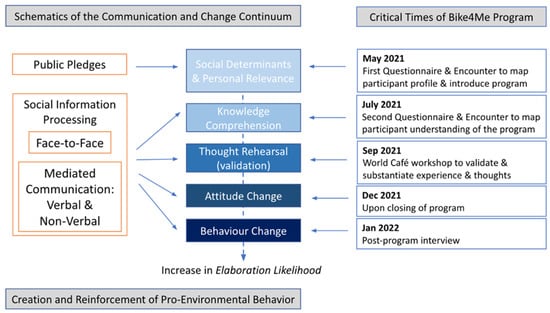
Figure 1.
Case study analysis based on the theoretical and analytical framework.
4.2. Portugal Mobility, Pilot Context, and Organization
Emissions from the mobility sector in Portugal have been increasing for a decade and it is the sector with the highest weight, 28%, in the country’s emissions since 2019 [56]. The sector has a target of reducing emissions by at least 40% by 2030. A shift to more intensive use of active mobility, such as using bicycles, effectively allows for substantial emissions reductions if adopted at a large scale.
Matosinhos, where the Bike4Me e-bike-sharing pilot program was conducted, is a municipality located in northwestern Portugal and by the Atlantic coast. It is the 10th most populous municipality nationally, with more than 175 thousand inhabitants and a size of 62.4 km2 [57]. More than half of the total GHG emissions of the municipality came from transportation in 2015 [58].
The municipal government of Matosinhos has set a goal to lead the decarbonization process nationally and become a climate-neutral city by 2030, following the European Commission’s Horizon Europe initiative. The municipality’s ambition goes further, to creating a bottom-up voluntary carbon market.
The Bike4Me bike-sharing pilot is part of the Matosinhos by AYR Program. It involves the municipality, companies, mobility operators, communities, and citizens to establish new mobility models that avoid emissions. The Bike4Me bike-sharing pilot is designed to enable participants to share a set of e-bikes with docks installed at various locations across the city and quantify and value the real-time CO2 emissions avoided.
By testing a pioneering model that rewards participants for the avoided carbon emissions from sustainable transport, the pilot also sought to enable residents to adopt a more sustainable lifestyle and enhance their sustainability understanding through concepts such as carbon neutrality and avoided emissions. The pilot was launched officially in June 2021 and was operated for six months. During the pilot, 58 participants who live and work within Matosinhos were recruited to participate with access to 17 bicycles spread across three dock stations.
Our analysis focused on critical aspects for a PEB: actors, behavior, and communication. We start by characterizing the socio-demography of the participants, then the processing of information that flows through several types of media used to communicate with the participants. Finally, as the participants of this mobility pilot already had some knowledge or experience with PEB, we focus on the evolution of their attitude towards avoiding CO2 emissions from an active mobility choice and how they value such mobility behavior and choice. The analytical framework fits in with the sequence of meetings, messages exchanged in the WhatsApp group, and the semi-structured interviews, all materials that supported the pilot case study, as it allows finding the correlations between variables to visualize the evolution of the ELM stages and how communication and information processing occurred at each step of the process.
5. Findings and Discussion
5.1. The Community Profile: Social Determinants and Initial Personal Relevance for Mobility Choices
The social determinants and the initial personal relevance of the participants group were mapped at the beginning of the Bike4Me program.
5.1.1. Social Determinants
- Gender: The participants of the Bike4Me pilot were 62% men and 38% women.
- Family situation: A dominant group of 64% has children, all of them between one and three children; 24% of them have two, and 22% have one child.
- Age: The leading age group is in a very professionally active period of life, between 35 and 44 years old, corresponding to 42% of the total. There are two other significant groups—between 25 and 34 years old and 45 and 54 years old, each one accounting for 22%. Young people (up to 24 years old) only account for 6%.
- Nationality: Portuguese is the dominant nationality origin of the group, representing 78% of the participants, whereas the 22% of non-Portuguese are an international community of Brazilian origin in particular—16%, but also of Chinese, Spanish, and Italian origin, with 2% each.
- Education: The single most significant group’s degree is secondary education—27.5%, but there is a strong presence of individuals with a postgraduate degree (10%), with around 31% indicating they have more than one degree (postgraduate, non-integrated master, and Ph.D. degrees).
- Profession: 82.7% of the group has a professional life, which 5.1% of them also do as working students, while 12% are full-time students or without a job. Workers are predominantly in public administration—18.9% as public servants, teaching, and health professionals, or in IT/telecommunications—13.7%.
- Health self-assessment: Almost the entire community (94%) self-assessed as having a good health condition (good, very good, or even excellent), and just 6% think they have a regular or bad health condition.
- Exercise habit: Despite their positive health self-assessment, they do not show a regular habit of physical exercise, nor is cycling their preferred activity, which is walking instead, such as urban walks and walking to work. In total, 72.4% of the group go on urban walks twice or three times a week, while 43.1% cycle at a similar frequency.
5.1.2. Initial Personal Relevance
The participants came into the pilot program with personal motivations and levels of knowledge relevant to the program. The personal initial motivations identified among the participants include health reasons, technological novelty, sustainability awareness, economic reasons, and other unspecified reasons. They either had some level of previous knowledge on sustainable mobility, climate change, and emissions or had a lack of knowledge. For the exact purpose of the program, the concepts of sustainability, avoided carbon emissions, and carbon neutrality were introduced gradually over the course of the 6-month pilot.
Sustainability awareness is the main motivation (33%), while economic reasons (14%) are the secondary motivation, and technology and health reasons were the smallest motivations for participants deciding to join the Bike4Me program.
The absolute majority (93%) have previous knowledge related to the subject of sustainable mobility, climate change, emissions reductions, and sustainability in general, and for 85% of the group, it is extremely important (70%) or very important (15%) to know the emissions that each one manages to reduce when using an e-bike.
During the week, 43% go to work on foot every day or regularly, whereas 25.8% choose cycling. The pilot developed under COVID-19 lockdowns, but participation was stable though more evident in the second half, with irregular distances (Figure 2).
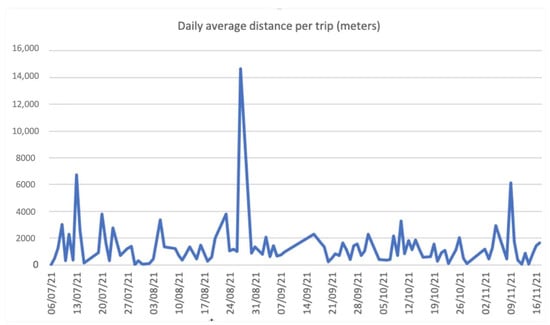
Figure 2.
Daily average distance per trip.
5.2. The Impact of Social Determinants and Personal Relevance on the Participants’ Perception, Thought Validation, and Attitude Change
We first analyze how each social determinant and personal relevance (motivation and cognition) influence the participants’ level of comprehension, level of thought rehearsal and validation, and level of attitude and behavior change. We then analyze the way communication and information processing occurred along each step of elaboration and of the Bike4Me program—whether it is verbal or non-verbal communication, at which point in time and for how long, whether it is face-to-face (FtF) or mixed digital-mediated communication, and how these means either positively or negatively contributed to the pro-environmental behavior elaboration outcome. Finally, we analyze how verbal and non-verbal communication affect participants’ emotions, whether they are satisfied, dissatisfied, or remain indifferent.
5.2.1. The Impact of Social Determinants and Personal Relevance on the Participant’s Perception
The participants’ level of perception of the program was assessed two months after the Bike4Me program started (see Figure 2), to understand how the social determinants and initial personal relevance have influenced their level of understanding, or comprehension of the program setup and the sustainability objectives behind. The participants’ comprehension category is assessed at three levels: comprehension, lack of comprehension, and distraction.
The following set of graphics shows the influence of each social determinant on the level of comprehension of the participants.
In general, the levels of education (Figure 3) tend to have an impact on the participant’s comprehension. The most dominant group is secondary school education, and they are mostly motivated by sustainability awareness and came into the program with previous knowledge. Most of them, the secondary school education respondents and the postgraduate education and Ph.D. degree participants, show a decent level of comprehension about the program and its objectives. Similarly, the group of participants with postgraduate degrees also are motivated by sustainability awareness or other reasons, but also curiosity to understand the technological novelty of the program and previous knowledge. At this stage, we do not know how much it was due to the level of education, and how much it was due to the initial motivations and cognitive conditions that resulted in the participant’s level of comprehension. The literature has contradictory evidence on the influence of education on the adoption of biking [12].
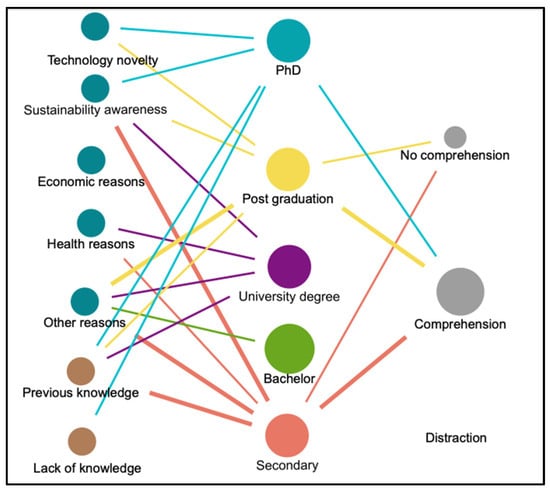
Figure 3.
Correlations between personal relevance, level of education, and level of comprehension. Note: the bubbles shown on this graphic indicate the variables and the lines indicate the correlation between two variables. The thickness of the lines shows the frequency of responses where the two variables were present. The size of the bubbles indicates the frequency of responses where the corresponding variable was present. We relate each social determinant (the bubbles on the center) with the motivation and initial cognition variables (the bubbles on the left) and with comprehension outcome (the bubbles on the right). The bubbles are invariably green blue for motivation, brown for initial cognition, and grey for comprehension. Social determinants and corresponding categories are different in each figure, and so are the colors to highlight them. The lines on the left relate social determinants with motivation and initial knowledge. The lines on the right indicate the influence of each social determinant category on the comprehension level.
The age difference (Figure 4) did not seem to have much influence on the participants’ level of comprehension. The younger group (25–34) were mostly motivated by technological novelty and sustainability awareness and mostly had some previous knowledge related to sustainable mobility. The middle group (35–44), similarly, were mostly motivated by technological novelty, followed by sustainability awareness and previous knowledge; however, had a mixed result between comprehension, no comprehension, and distraction. The middle-senior group (45–54) was motivated primarily by sustainability awareness and previous knowledge and was mostly able to comprehend the program. The senior group (55–64) performed very similarly to the younger group (25–34). To summarize, younger participants tend to be driven mostly by technological novelty, while older participants tend to be driven mostly by sustainability awareness. But the age differences did not have a major effect on the participants’ level of comprehension.
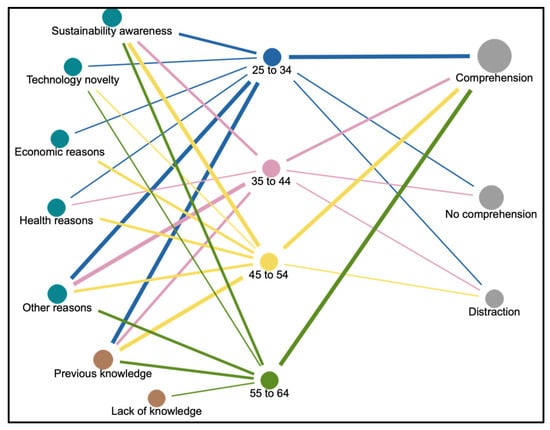
Figure 4.
Correlations between personal relevance, age, and level of comprehension.
The health condition does not seem to have much influence on comprehension level (Figure 5). Most of the group has a very positive assessment of their health condition, as most participants assessed their health as “very good”, with a small few assessing it as “good” and “excellent”. They have multiple motivations, of which sustainability awareness stands out, and some previous knowledge. Almost all of them reached the comprehension level.
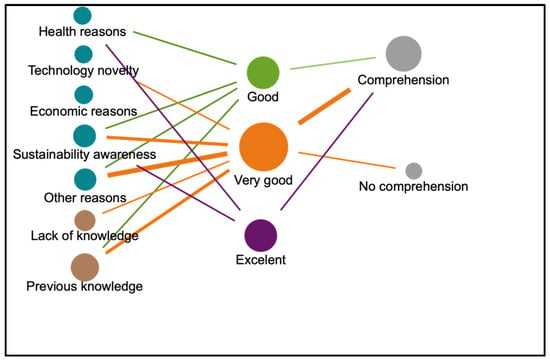
Figure 5.
Correlations between personal relevance, health status, and level of comprehension.
Nationality does not seem to influence the level of comprehension of the participants (Figure 6), since almost all of them were able to comprehend. Portuguese participants expressed more motivation and were more represented in terms of previous knowledge and the level of comprehension, as they represented about 3/4 of the group. Sustainability awareness and other reasons are the main motivations.
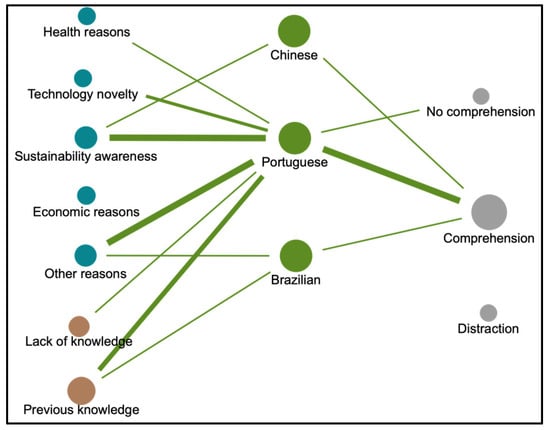
Figure 6.
Correlations between personal relevance, nationality, and level of comprehension.
The types of professions also do not seem to have much influence on participants’ level of comprehension (Figure 7). Most participants achieve a decent level of comprehension of the set-ups and the objectives of the program regardless of the types of profession, although being employed can influence comprehension. Most participants entered the program driven by their sustainability awareness and some other reasons, and most of them have some previous sustainable mobility knowledge.
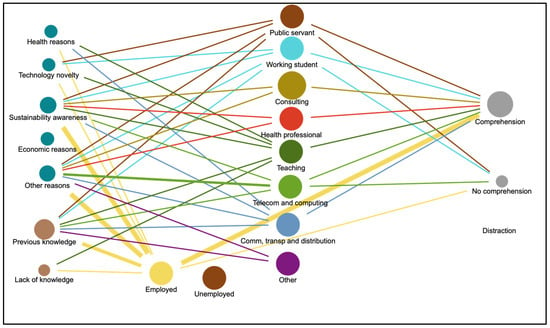
Figure 7.
Correlations between personal relevance, profession, and level of comprehension.
Family status seems to have some influence on comprehension level (Figure 8). It seems more likely that those who are childless or have one child achieve a decent level of comprehension of the program. They are also the majority in the group. The childless participants are also the most motivated, primarily by technological novelty, sustainability awareness, and other reasons. They also came into the program with some previous knowledge.
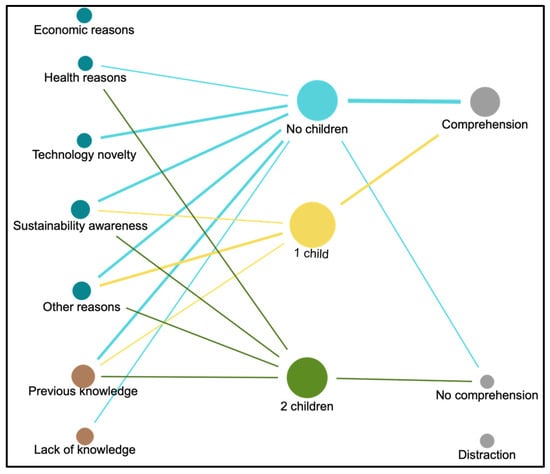
Figure 8.
Correlations between personal relevance, family status, and level of comprehension.
Gender does not seem to have much influence on comprehension level (Figure 9). Both male and female participants had decent previous knowledge and reached a decent level of comprehension; it is hard to say which group had a better comprehension than the other. Both groups were driven primarily by sustainability awareness; however, it is evident that female participants were also driven primarily by economic reasons whilst male participants were also driven primarily by other reasons.
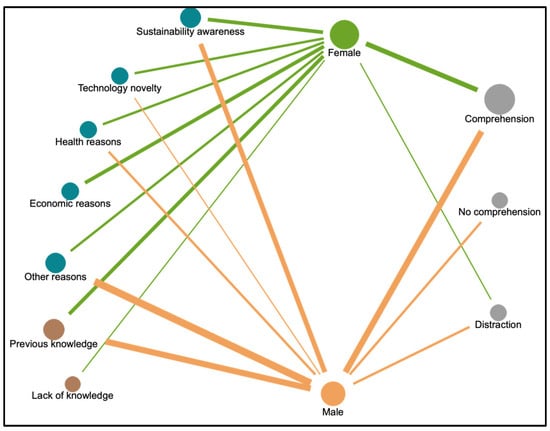
Figure 9.
Correlations between personal relevance, gender, and level of comprehension.
5.2.2. The Impact of Social Determinants and Personal Relevance on the Participants’ Perception, Thought Validation, and Choices of Sustainable Mobility
Social determinants, initial motivations, and initial levels of cognition are all endogenous factors that participants carried within themselves upon entering the Bike4Me program. Among the three, initial motivation was the strongest factor that contributed to the level of comprehension, irrespective of individual participants’ level of previous knowledge or their age, gender, education, profession, etc.
Furthermore, even with no comprehension and distractions, some were able to strive to comprehend later and validate positively their thoughts on the program. Among those who validated their thoughts positively, the majority were able to have a central positive attitude change.
Sustainability awareness is the environmental motivation and the most strongly correlated with other variables, while economic reasons are the least. This confirms the importance of motives as predictors of attitude and behavior change [26].
To summarize, social determinants do not have a definitive influence on the final attitude change of pro-environmental behavior in this pilot group, neither if the participants have previous knowledge about sustainable mobility or relevant technology (Figure 10). Initial motivations, such as sustainability awareness, health reasons, technological novelty, and other reasons, give a much stronger push to the participants upon the commencement of the Bike4Me program. This is refreshing news for existing municipal sustainability innovation pilot programs, as they tend to place the focus on the average participant’s profile being able to reflect the demographic composition of their societies. Programs that follow this traditional pilot design aim to anticipate what the social response will be. As for sustainability pilot programs, they should prioritize participants’ stimulation.
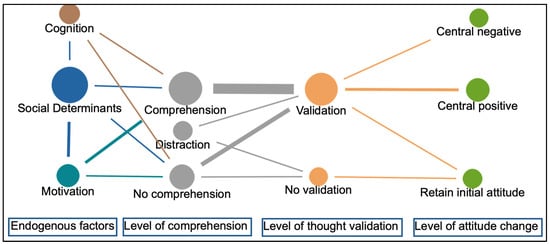
Figure 10.
Correlation path between endogenous factors (social determinants, initial cognition, and motivation), level of comprehension, level of thought validation, and level of attitude change, all along the elaboration continuum. Note: the bubbles indicate the variables, and the lines indicate the correlation between two variables. The thickness of the lines shows the frequency of responses where two variables were present. The size of the bubbles indicates the frequency of responses where this variable was present.
As motivations are the strongest push for participants in such programs, it is important for municipalities to design mechanisms that take this variable into account in further policy decisions.
5.2.3. The Processing of Social Information and Resultant Emotions in Each PEB Elaboration Stage
In this subsection, we analyze the way in which participants processed information, in the context of pilot communication, along each step of elaboration and of the Bike4Me program—whether it was face-to-face communication (encounters), digital-mediated verbal (texts like terms and conditions, real time information on CO2 emissions avoided each trip, and questionnaires) or non-verbal communication (messages as images, emoticons, audio, video), or mixed digital-mediated (MDM) communication (messages gathering text, image, emoticons, audio, video), at which point in time and for how long, and how these means either positively or negatively contributed to the pro-environmental behavior elaboration outcome.
Participants were able to reach a high level of knowledge comprehension through FtF communication and MDM communication, but that did not happen when messages based only on verbal cues or non-verbal cues were exchanged (Figure 11). This is reasonable as FtF communication facilitates understanding by enabling in-personal contact, during which multiple information could be exchanged, including body language and facial expression. And, due to the expanding possible cues allowed, resulting in a larger bandwidth, MDMC can be now almost as effective as FtF communication, according to the results. Participants showed relatively low levels of not comprehending via FtF communication and non-verbal communication but higher levels of not comprehending when verbal (text) and MDM communication were used. Some participants who were distracted were primarily distracted because of MDM communication. This is possiblly because some participants relied on digital-mediated communication as the sole means of communication (most of them did not attend those in-person encounters). In the thought rehearsal step, participants were able to self-validate their thoughts and make their judgments using FtF and MDM communication but much less with verbal communication alone. That means participants could not reach reliable thoughts only through verbal communication. No participant showed peripheral attitude change (superficial, slight, and temporary change; susceptible to counter-persuasion), which is coherent with the fact that participants came with a pro-environmental attitude. As for an enduring attitude change and predictive of behavior, participants who were able to shift their attitude positively attributed it to FtF and MDM communication, although the same communication means were also accounted for by those who did not change their attitude at all. This is possibly because FtF and MDM communication were the remaining means of communication towards the end of the Bike4Me pilot program. In the last step of the elaboration process, more participants maintained the behavior than those who changed it, and their communication means were very similar, through both FTF and MDM communication. To summarize, participants are more likely to reach knowledge comprehension through FtF and MDMC, and subsequently therefore reach thought rehearsal and attitude change.

Figure 11.
Relationships between the ways of communication and the resultant elaboration status of participants’ pro-environmental behavior. Note: Each square indicates the relationship between two variables. The stronger the relationship between the two, the more the size and color change. Gradually, the size increases and the color changes from blue, to dark grey, to dark red, to red.
FTF and MDMC communication reached the highest performance levels, being the two ways of communication that most positively and strongly affect the critical aspects of persuasive communication for the success of an elaboration process from comprehension to thought validation and leading to central positive attitude change. FtF communication resulted in the lowest levels of no comprehension and distraction, making it the most engaging way of knowledge comprehension. However, FtF communication is markedly less influential on behavior change, and MDM is even much less. Three reasons can explain the low degree of embodiment: the obstacles caused by the COVID pandemic to the regular use of mobility, and the coincidence between the beginning of winter and the end of the pilot. Verbal communication (text) alone almost did not influence the elaboration processing, and non-verbal communication did not influence it at all. Both forms of digital communication are ineffective in communicating the message of sustainability and sustainable choices of mobility.
This Bike4Me pilot program took place amid the COVID pandemic when digital communication was the only form of communication allowed for some periods, while intermittent periods of face-to-face communication were allowed. Further research could compare differences and similarities in levels of understanding, validation, and attitude changes from those that were observed.
6. Conclusions
In this paper, we focused on the formation and reinforcement of PEB of urban mobility in the southern European small municipality context. We aimed to understand whether and how endogenous factors, including social determinants, personal motivation, and cognition level influence citizens’ level of comprehension of sustainable mobility and behavior change. We studied an empirical urban sustainable mobility pilot program called Bike4Me in Matosinhos, Portugal, under the analytical framework of the Elaboration Likelihood Model (ELM), Social Information Processing Theory (SIPT), and MaxQDA 2022 correlational qualitative analysis software.
Sustainability awareness was the leading motivation for why participants decided to join the Bike4Me program, and the absolute majority have previous knowledge related to the subject of sustainable mobility, climate change, emissions reductions, and sustainability in general. Among all the social determinants, education was the only one that impacted the participant’s comprehension. The most dominant group was secondary school education, and they were mostly motivated by sustainability awareness and came into the program with previous knowledge. We also identified an impact from family status, as the number of children appears to be inversely proportional to the level of comprehension of sustainability. The age difference did not have much influence on the participants’ level of comprehension, nor did health status, nationality, profession, or gender. Most of the participants reached a decent level of comprehension.
Among the three endogenous factors—social determinants, initial motivation, and initial levels of cognition, initial motivation was the strongest factor that contributed to comprehension. Among those who validated their thoughts positively, the majority were able to have a central positive attitude change towards PEB. This is a novel finding, given that municipal sustainability innovation pilot programs tend to focus on the participant’s profile being representative of the average demographic composition. This means it is important to design mechanisms that select citizens who are the most motivated as they can drastically elevate the success rate of such programs and be active citizen ambassadors and leaders in the sustainability innovations.
Verbal FtF and MDM are the types of communication that helped participants better understand the information on embodying sustainable mobility. The similar effectiveness (rate) between the two types of communication is mainly due to the significant bandwidth expansion of digital-mediated communication, thus needing fewer cumulative interactions to reach a similar level of relational communication. FtF and MDM communication positively contributed to the elaboration process, promoting comprehension and thought validation, and ultimately leading to central positive attitude change.
On the contrary, exclusively verbal or non-verbal messages contributed negatively to the change in attitude, mainly resulting in non-comprehension and distraction. Finally, FtF and MDMC communications contributed most to the participant’s satisfaction with their overall sustainability experience in the Bike4Me program. But the same is also true for those that were frustrated or dissatisfied. This is probably because through FtF communication and MDM, participants were able to express their feelings more often than text-based and other non-verbal communications. Furthermore, the group that was frustrated/dissatisfied used less FtF communication and used more MDM, possibly because more frequent FtF communication led to greater satisfaction, or MDM communication is more favored for expressing frustration and dissatisfaction.
Either way, future municipal sustainability pilot programs like the Bike4Me program could learn from this by using more FtF communication to facilitate participants’ understanding and convey more positive feelings about their experience. Our research added another dimension to PEB research through focusing on communication and information processing. Previous research tends to show how social-cultural and economic contexts influence embodied values and the speed of mindset evolution, and that is a valid line of thought for policymaking. Our research, then, additionally focused on the importance of (1) designing programs that effectively stimulate citizen’s motivation and (2) that effectively facilitate the positive exchange of information and emotions via primarily in-person face-to-face communication, and combined with audience-adequate (tech-savvy) modern communication content (such as MDM communication) to enhance citizens’ experience in such pilot programs.
We also recognize some limitations of this study: the pandemic restrictions did not allow us to test how to reward reduced CO2 emissions due to the small sample size and limited consistency of enabling environment over the test period. Further research should broaden the scope of the search in two directions: it should build a comparative base for developed and developing country contexts and demonstrate differences in policies and choices between countries with different climatic conditions but within the same region when adopting sustainable urban mobility.
Finally, although the context of a southern European case study cannot be analogized, much less applied directly in other cities globally, we consider our study may be useful for local transport policy, as the effective angle to stimulate citizen participation (through addressing individuals’ intrinsic motivation) and to facilitate their participation (effective, audience-adequate communication) are two universal elements that municipality sustainability or innovation programs could improve on to achieve better outcomes.
Author Contributions
Conceptualization, L.J.F. and J.L.; Methodology, L.J.F. and J.L.; Software, L.J.F. and J.L.; Validation, L.J.F. and J.L.; Formal analysis, L.J.F. and J.L.; Investigation, L.J.F. and J.L.; Resources, L.J.F. and J.L.; Data curation, L.J.F. and J.L.; Writing—original draft, L.J.F. and J.L.; Writing—review & editing, L.J.F. and J.L.; Visualization, L.J.F. and J.L.; Supervision, L.J.F.; Project administration, L.J.F. All authors have read and agreed to the published version of the manuscript.
Funding
This research was funded by PRR—Investimento RE-C05-i02: Missão Interface—CoLAB CEiiA. The APC was funded by CEiiA.
Institutional Review Board Statement
Not applicable.
Informed Consent Statement
Informed consent was obtained from all subjects involved in the study.
Data Availability Statement
Not applicable.
Conflicts of Interest
The authors declare no conflict of interest.
Correction Statement
This article has been republished with a minor correction to the Funding statement. This change does not affect the scientific content of the article.
References
- EEA. Transport and Environment Report 2019: The First and the Last Mile. 2019. Available online: https://www.eea.europa.eu/publications/the-first-and-last-mile (accessed on 3 August 2023).
- IPCC. IPCC Fifth Assessment Report. Climate Change 2014: Impacts, Adaptation, and Vulnerability; Field, C.B., Barros, V.R., Eds.; Cambridge University Press: Cambridge, UK, 2014; Available online: https://www.ipcc.ch/report/ar5/wg2/ (accessed on 3 August 2023).
- IPCC. Climate Change 2022—Impacts, Adaptation and Vulnerability; Pörtner, H.-O., Roberts, D.C., Tignor, M., Poloczanska, E.S., Mintenbeck, K., Alegría, A., Craig, M., Langsdorf, S., Löschke, S., Möller, V., et al., Eds.; Cambridge University Press: Cambridge, UK, 2023. [Google Scholar] [CrossRef]
- Ferreira, L.J.; Dias, L.P.; Liu, J. Adopting Carbon Pricing Tools at the Local Level: A City Case Study in Portugal. Sustainability 2022, 14, 1812. [Google Scholar] [CrossRef]
- Jiang, B.; He, Z.; Xue, W.; Yang, C.; Zhu, H.; Hua, Y.; Lu, B. China’s Low-Carbon Cities Pilot Promotes Sustainable Carbon Emission Reduction: Evidence from Quasi-Natural Experiments. Sustainability 2022, 14, 8996. [Google Scholar] [CrossRef]
- Hussain, J.; Lee, C. A Green Path towards Sustainable Development: Optimal Behavior of the Duopoly Game Model with Carbon Neutrality Instruments. Sustain. Dev. 2022, 30, 1523–1541. [Google Scholar] [CrossRef]
- Vagnoni, E.; Moradi, A. Local Government’s Contribution to Low Carbon Mobility Transitions. J. Clean. Prod. 2018, 176, 486–502. [Google Scholar] [CrossRef]
- Wimbadi, R.W.; Djalante, R.; Mori, A. Urban Experiments with Public Transport for Low Carbon Mobility Transitions in Cities: A Systematic Literature Review (1990–2020). Sustain. Cities Soc. 2021, 72, 103023. [Google Scholar] [CrossRef]
- Martin, E.; Stocker, A.; Nichols, A. Roundtrip Carsharing in New York City: An Evaluation of a Pilot Program and System Impacts; Institute of Transportation Studies, University of California: Berkeley, CA, USA, 2021. [Google Scholar] [CrossRef]
- Mitra, R.; Hess, P.M. Who Are the Potential Users of Shared E-Scooters? An Examination of Socio-Demographic, Attitudinal and Environmental Factors. Travel Behav. Soc. 2021, 23, 100–107. [Google Scholar] [CrossRef]
- Negev, M.; Garb, Y.; Biller, R.; Sagy, G.; Tal, A. Environmental Problems, Causes, and Solutions: An Open Question. J. Environ. Educ. 2009, 41, 101–115. [Google Scholar] [CrossRef]
- Javaid, A.; Creutzig, F.; Bamberg, S. Determinants of Low-Carbon Transport Mode Adoption: Systematic Review of Reviews. Environ. Res. Lett. 2020, 15, 103002. [Google Scholar] [CrossRef]
- Van Elslande, P.; Feypell-de la Beaumelle, V.; Holgate, J.; Redant, K.; de Solère, H.; Margaritis, D.; Yannis, G.; Papadimitriou, E.; de Craen, S.; Inge Haslie, L.; et al. Mobility and Safety of Powered Two-Wheelers in OECD Countries. Traffic Saf. 2016, 4, 101–117. [Google Scholar] [CrossRef]
- Chatterton, T. An Introduction to Thinking about “Energy Behaviour”: A Multi-Model Approach; University of the West of England: Bristol, UK, 2011. [Google Scholar]
- Philips, I.; Anable, J.; Chatterton, T. A Small Area Estimation of the Capability of Individuals to Replace Car Travel with Walking, Cycling and e-Bikes and Its Implications for Energy Use. In Proceedings of the ECEEE Summer Study Proceedings, Presqu’île de Giens, France, 3–8 June 2019. [Google Scholar]
- Philips, I.; Anable, J.; Chatterton, T. E-Bikes and Their Capability to Reduce Car CO2 Emissions. Transp. Policy 2022, 116, 11–23. [Google Scholar] [CrossRef]
- Bourne, J.E.; Cooper, A.R.; Kelly, P.; Kinnear, F.J.; England, C.; Leary, S.; Page, A. The Impact of E-Cycling on Travel Behaviour: A Scoping Review. J. Transp. Health 2020, 19, 100910. [Google Scholar] [CrossRef]
- McQueen, M.; MacArthur, J.; Cherry, C. The E-Bike Potential: Estimating Regional e-Bike Impacts on Greenhouse Gas Emissions. Transp. Res. D Transp. Environ. 2020, 87, 102482. [Google Scholar] [CrossRef]
- ITF. Good to Go? Assessing the Environmental Performance of New Mobility; OECD Publishing: Paris, France, 2020. [Google Scholar] [CrossRef]
- Cairns, S.; Behrendt, F.; Raffo, D.; Beaumont, C.; Kiefer, C. Electrically-Assisted Bikes: Potential Impacts on Travel Behaviour. Transp. Res. Part A Policy Pract. 2017, 103, 327–342. [Google Scholar] [CrossRef]
- Fyhri, A.; Fearnley, N. Effects of E-Bikes on Bicycle Use and Mode Share. Transp. Res. D Transp. Environ. 2015, 36, 45–52. [Google Scholar] [CrossRef]
- Zhou, Q.; Che, M.; Koh, P.P.; Wong, Y.D. Effects of Improvements in Non-Motorised Transport Facilities on Active Mobility Demand in a Residential Township. J. Transp. Health 2020, 16, 100835. [Google Scholar] [CrossRef]
- Sottile, E.; Piras, F.; Calli, D.; Meloni, I. Why Don’t Italians Cycle to Work? An Experimental Analysis. Case Stud. Transp. Policy 2021, 9, 362–373. [Google Scholar] [CrossRef]
- Koszowski, C.; Gerike, R.; Hubrich, S.; Götschi, T.; Pohle, M.; Wittwer, R. Active Mobility: Bringing Together Transport Planning, Urban Planning, and Public Health. In Towards User-Centric Transport in Europe: Challenges, Solutions and Collaborations; Springer: Berlin/Heidelberg, Germany, 2019. [Google Scholar] [CrossRef]
- Kang, A.S.; Jayaraman, K.; Soh, K.L.; Wong, W.P. Convenience, Flexible Service, and Commute Impedance as the Predictors of Drivers’ Intention to Switch and Behavioral Readiness to Use Public Transport. Transp. Res. Part F Traffic. Psychol. Behav. 2019, 62, 505–519. [Google Scholar] [CrossRef]
- Herberz, M.; Hahnel, U.J.J.; Brosch, T. The Importance of Consumer Motives for Green Mobility: A Multi-Modal Perspective. Transp. Res. Part A Policy Pract. 2020, 139, 102–118. [Google Scholar] [CrossRef]
- Linder, N.; Giusti, M.; Samuelsson, K.; Barthel, S. Pro-Environmental Habits: An Underexplored Research Agenda in Sustainability Science. Ambio 2022, 51, 546–556. [Google Scholar] [CrossRef]
- Schoenau, M.; Müller, M. What Affects Our Urban Travel Behavior? A GPS-Based Evaluation of Internal and External Determinants of Sustainable Mobility in Stuttgart (Germany). Transp. Res. Part F Traffic. Psychol. Behav. 2017, 48, 61–73. [Google Scholar] [CrossRef]
- Marsden, G.; Anable, J.; Chatterton, T.; Docherty, I.; Faulconbridge, J.; Murray, L.; Roby, H.; Shires, J. Studying Disruptive Events: Innovations in Behaviour, Opportunities for Lower Carbon Transport Policy? Transp. Policy 2020, 94, 89–101. [Google Scholar] [CrossRef]
- An, Z.; Heinen, E.; Watling, D. The Level and Determinants of Multimodal Travel Behavior: Does Trip Purpose Make a Difference? Int. J. Sustain. Transp. 2023, 17, 103–117. [Google Scholar] [CrossRef]
- Lindsay, G.; Macmillan, A.; Woodward, A. Moving Urban Trips from Cars to Bicycles: Impact on Health and Emissions. Aust. N. Z. J. Public Health 2011, 35, 54–60. [Google Scholar] [CrossRef] [PubMed]
- Johansson, C.; Lövenheim, B.; Schantz, P.; Wahlgren, L.; Almström, P.; Markstedt, A.; Strömgren, M.; Forsberg, B.; Sommar, J.N. Impacts on Air Pollution and Health by Changing Commuting from Car to Bicycle. Sci. Total Environ. 2017, 584–585, 55–63. [Google Scholar] [CrossRef] [PubMed]
- Sundfør, H.B.; Fyhri, A.; Bjørnarå, H.B. E-Bikes-Good for Public Health? In Advances in Transportation and Health: Tools, Technologies, Policies, and Developments; Elsevier: Amsterdam, The Netherlands, 2020; pp. 251–266. [Google Scholar] [CrossRef]
- Sundfør, H.B.; Fyhri, A. A Push for Public Health: The Effect of e-Bikes on Physical Activity Levels. BMC Public Health 2017, 17, 809. [Google Scholar] [CrossRef]
- Tian, H.; Liu, X. Pro-Environmental Behavior Research: Theoretical Progress and Future Directions. Int. J. Environ. Res. Public Health 2022, 19, 6721. [Google Scholar] [CrossRef]
- Scheerder, A.; van Deursen, A.; van Dijk, J. Determinants of Internet Skills, Uses and Outcomes. A Systematic Review of the Second- and Third-Level Digital Divide. Telemat. Inform. 2017, 34, 1607–1624. [Google Scholar] [CrossRef]
- Biehl, A.; Chen, Y.; Sanabria-Véaz, K.; Uttal, D.; Stathopoulos, A. Where Does Active Travel Fit within Local Community Narratives of Mobility Space and Place? Transp. Res. Part A Policy Pract. 2019, 123, 269–287. [Google Scholar] [CrossRef]
- Banerjee, S.; Savani, M.; Shreedhar, G. Public Support for ‘Soft’ versus ‘Hard’ Public Policies: Review of the Evidence. J. Behav. Public Adm. 2021, 4, 1–2. [Google Scholar] [CrossRef]
- Saari, U.A.; Damberg, S.; Frömbling, L.; Ringle, C.M. Sustainable Consumption Behavior of Europeans: The Influence of Environmental Knowledge and Risk Perception on Environmental Concern and Behavioral Intention. Ecol. Econ. 2021, 189, 107155. [Google Scholar] [CrossRef]
- Manca, S.; Fornara, F. Attitude toward Sustainable Transport as a Function of Source and Argument Reliability and Anticipated Emotions. Sustainability 2019, 11, 3288. [Google Scholar] [CrossRef]
- Michie, S.; van Stralen, M.M.; West, R. The Behaviour Change Wheel: A New Method for Characterising and Designing Behaviour Change Interventions. Implement. Sci. 2011, 6, 42. [Google Scholar] [CrossRef]
- Ajzen, I. The Theory of Planned Behavior. Organ. Behav. Hum. Decis. Process. 1991, 50, 179–211. [Google Scholar] [CrossRef]
- Lanzini, P.; Khan, S.A. Shedding Light on the Psychological and Behavioral Determinants of Travel Mode Choice: A Meta-Analysis. Transp. Res. Part F Traffic. Psychol. Behav. 2017, 48, 13–27. [Google Scholar] [CrossRef]
- Chng, S. Advancing Behavioural Theories in Sustainable Mobility: A Research Agenda. Urban Sci. 2021, 5, 43. [Google Scholar] [CrossRef]
- Klöckner, C.A.; Blöbaum, A. A Comprehensive Action Determination Model: Toward a Broader Understanding of Ecological Behaviour Using the Example of Travel Mode Choice. J. Environ. Psychol. 2010, 30, 574–586. [Google Scholar] [CrossRef]
- Petty, R.E.; Brinol, P. The Elaboration Likelihood Model BT. In Handbook of Theories of Social Psychology: Volume 1; Sage Publications Ltd.: London, UK, 2012. [Google Scholar]
- Petty, R.E.; Brifiol, P.; Priester, J.R. Mass Media Attitude Change: Implications of the Elaboration Likelihood Model of Persuasion. In Media Effects: Advances in Theory and Research; Routledge: Abingdon, UK, 2009. [Google Scholar]
- Manca, S.; Altoè, G.; Schultz, P.W.; Fornara, F. The Persuasive Route to Sustainable Mobility: Elaboration Likelihood Model and Emotions Predict Implicit Attitudes. Environ. Behav. 2020, 52, 830–860. [Google Scholar] [CrossRef]
- Wu, F.; Hu, X.; An, S.; Zhang, D. Exploring Passengers’ Travel Behaviors Based on Elaboration Likelihood Model under the Impact of Intelligent Bus Information. J. Adv. Transp. 2019, 2019, 9095279. [Google Scholar] [CrossRef]
- Walther, J.B. Interpersonal Effects in Computer-Mediated Interaction: A Relational Perspective. Communic. Res. 1992, 19, 52–90. [Google Scholar] [CrossRef]
- Walther, J.B. Relational Aspects of Computer-Mediated Communication: Experimental Observations over Time. Organ. Sci. 1995, 6, 186–203. [Google Scholar] [CrossRef]
- Carr, C.T. CMC Is Dead, Long Live CMC!: Situating Computer-Mediated Communication Scholarship Beyond the Digital Age. J. Comput.-Mediat. Commun. 2020, 25, 9–22. [Google Scholar] [CrossRef]
- Yao, M.Z.; Ling, R. “What Is Computer-Mediated Communication?”—An Introduction to the Special Issue. J. Comput.-Mediat. Commun. 2020, 25, 4–8. [Google Scholar] [CrossRef]
- Walther, J.B. Social Information Processing Theory: Impressions and Relationshsip Development Online. In Engaging Theories in Interpersonal Communication: Multiple Perspectives, 2nd ed.; Braithwaite, D.O., Schrodt, P., Eds.; Sage: Newcastle upon Tyne, UK, 2015. [Google Scholar]
- Krippendorf, K. Content Analysis: Fundamentals of Methodology; Sage: Newcastle upon Tyne, UK, 2004. [Google Scholar]
- APAmbiente. Portuguese National Inventory Report on Greenhouse Gases Emissions 1990–2019. Available online: https://apambiente.pt/sites/default/files/_Clima/Inventarios/20221025NIR2022JulyCorrigendum.pdf (accessed on 12 January 2023).
- AMP. Available online: http://portal.amp.pt/pt/4/municipios/ (accessed on 5 August 2023).
- DGEG. Natural Gas, Oil Products and Electricity Consumption per Sector and Municipality in Portugal for 2015; DGEG: Lisbon, Portugal, 2021.
Disclaimer/Publisher’s Note: The statements, opinions and data contained in all publications are solely those of the individual author(s) and contributor(s) and not of MDPI and/or the editor(s). MDPI and/or the editor(s) disclaim responsibility for any injury to people or property resulting from any ideas, methods, instructions or products referred to in the content. |
© 2023 by the authors. Licensee MDPI, Basel, Switzerland. This article is an open access article distributed under the terms and conditions of the Creative Commons Attribution (CC BY) license (https://creativecommons.org/licenses/by/4.0/).